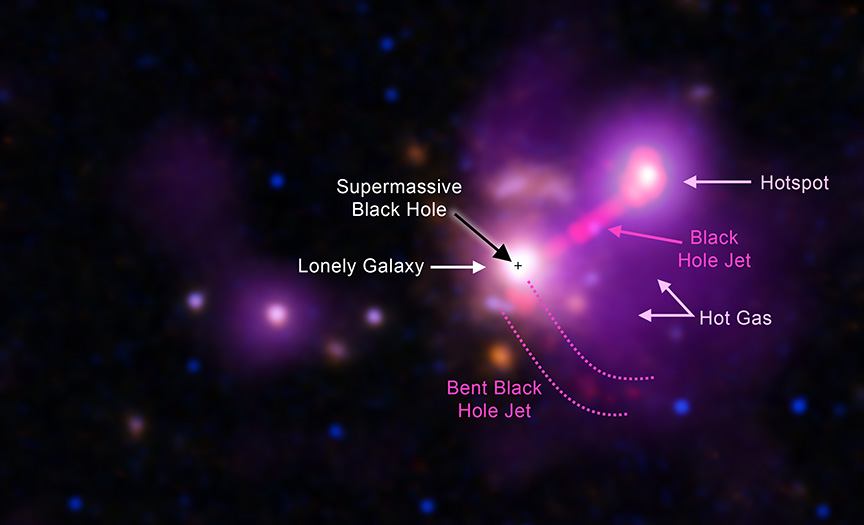CXC: Astronomers Discover a Surprisingly Lonely Galaxy
Posted: Thu Mar 09, 2023 5:30 am
3C 297: Astronomers Discover a Surprisingly Lonely Galaxy
NASA | MSFC | SAO | Chandra X-ray Observatory | 2023 Mar 08
Powerful Yet Lonely: Is 3C 297 a High-Redshift Fossil Group? ~ Valentina Missaglia et al
NASA | MSFC | SAO | Chandra X-ray Observatory | 2023 Mar 08
This image features a galaxy called 3C 297 that is lonelier than expected after it likely pulled in and absorbed its former companion galaxies, as described in our latest press release. The solo galaxy is located about 9.2 billion light-years from Earth and contains a quasar, a supermassive black hole pulling in gas at the center of the galaxy and driving powerful jets of matter seen in radio waves. This result made with NASA’s Chandra X-ray Observatory and the International Gemini Observatory may push the limits for how quickly astronomers expect galaxies to grow in the early universe.X-ray: NASA/CXC/Univ. of Torino/V. Missaglia et al.;
Optical: NASA/ESA/STScI & Gemini/NOIRLab/NSF/AURA;
Infrared: NASA/ESA/STScI; Radio: NRAO/AUI/NSF
In several regards, 3C 297 has the qualities of a galaxy cluster, a gigantic structure that contains hundreds or even thousands of individual galaxies. X-ray data from Chandra reveal large quantities of gas heated to millions of degrees — a signature feature of a galaxy cluster. Astronomers also found a jet from the quasar — seen by the Karl G. Jansky Very Large Array — that has been bent by interacting with its surroundings. Finally, Chandra data shows evidence that the other quasar jet has smashed into the gas around it, creating a “hotspot” of X-rays. These are typically characteristics of a galaxy cluster. Yet, data from the Gemini Observatory show there is only one galaxy in 3C 297. The nineteen galaxies that appear close to 3C 297 in a Gemini image are actually at much different distances.
In this new composite image, Chandra data is colored purple, VLA data is red and Gemini data is green. Visible light and infrared data from the Hubble Space Telescope (blue and orange respectively) have also been included. The lonely galaxy (3C 297) and the position of its supermassive black are identified in a labeled version of the image, along with the black hole’s jets, the X-ray hotspot and the hot gas. The field of view of this image is too small to show any of the 19 galaxies that are not at the same distance as 3C 297. ...
Powerful Yet Lonely: Is 3C 297 a High-Redshift Fossil Group? ~ Valentina Missaglia et al
- Astrophysical Journal Supplement Series 264(1):6 (Jan 2023) DOI: 10.3847/1538-4365/ac9f3e
- arXiv > astro-ph > arXiv:2212.01707 > 03 Dec 2022

